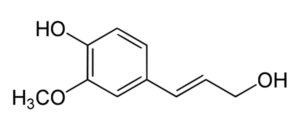Interesting facts from the world of organic chemistry
Derivatives - phenols:
Coniferyl alcohol
Coniferyl alcohol or coniferol is an organic compound with two hydroxyl (OH) groups. Coniferol is one of the representatives of the monolignol group. Monolignols are phytochemicals acting as a source material for the biosynthesis of both lignans and lignin itself. Coniferol monolignols are one of the three main phytochemicals that make up lignin. Lignin is further composed of sinapol and 1,4-coumarol. These basic components are cross-linked in the lignin structure via β-O-4, β-1, β-5, β-β, 4-O-5 and 5-5 bonds.
Coniferol belongs to pheromones. Coniferol is important, among other things, for its fluorescent properties.

Picture above: Molecular structure of coniferol.
Coniferol can be prepared from phenol by a sequence of reactions. First, vanillin is prepared, which is converted to coniferol by further reactions.

Picture above: Scheme for the preparation of vanillin from phenol as an intermediate step for the preparation of coniferol.
The prepared vanillin is converted by a sequence of reactions to coniferol as indicated in the diagram below.

Picture above: Preparation of coniferol from vanillin.
Sources:
[1] Nadace Mateřská Naděje, „Mateřská Naděje,“ [Online]. Available: http://www.materska-nadeje.cz/slovnik.htm. [Přístup získán 7 6 2013].
[2] V. Rochira, B. Madeo, C. Diazzi, L. Zirilli, D. Santi a C. Carani, „Estrogens and Male Reproduction,“ Endotext.com, 6 2 2013. [Online]. Available: http://www.endotext.org/male/male17/male17.htm. [Přístup získán 7 6 2013].
[3] W. F. Boron a E. L. Boulpaep, v Medical Physiology: A Cellular And Molecular Approach, Saunders, 2003, p. 1300.
[4] E. K. Achyuthan, P. D. Adams, S. Datta, B. A. Simmons a A. K. Singh, „Molecules,“ 2010. [Online]. Available: http://www.mdpi.com/1420-3049/15/3/1645. [Přístup získán 7 6 2013].
[5] J. Ralph a Y. Zhang, „Agricultural Research Service,“ 1998. [Online]. Available: http://www.dfrc.ars.usda.gov/DFRCWebPDFs/1998-Ralph-Tet-54-1349.pdf. [Přístup získán 7 6 2013].
[6] M. Bolognini, F. Cavani, L. D. Pozzo, L. Maselli, F. Zaccarelli, B. Bonelli, M. Armandi a E. Garrone, „ScienceDirect,“ 21 5 2004. [Online]. Available: http://www.sciencedirect.com/science/article/pii/S0926860X04004703. [Přístup získán 7 6 2013].
[7] J. Moravcová, v Biologicky aktivní přírodní látky, Praha, VŠCHT Praha, 2006, pp. 33-34.
[8] OSHA, „United States Department of Labor,“ 30 3 2007. [Online]. Available: http://www.osha.gov/dts/chemicalsampling/data/CH_238925.html. [Přístup získán 7 6 2013].
[9] „National Toxicology Program,“ 2011. [Online]. Available: http://ntp.niehs.nih.gov/ntp/roc/twelfth/profiles/EstrogensSteroidal.pdf. [Přístup získán 7 6 2013].
[10] Health, „Healthy & Hot,“ 18 7 2007. [Online]. Available: http://www.healthyandhot.com/everything_you_wanted_to_know_about_olestra.htm. [Přístup získán 7 6 2013].
[11] P. Brancová, „Informační systém Masarykovy univerzity,“ 15 7 2008. [Online]. Available: http://is.muni.cz/th/106399/prif_m/Diplomova_prace.pdf. [Přístup získán 8 6 2013].
